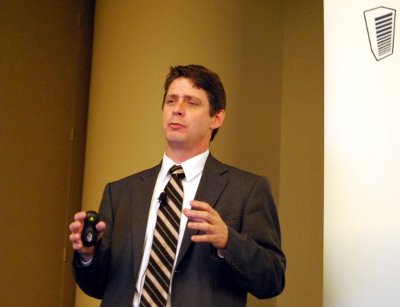The City and County of San Francisco’s budget troubles have proven to be beneficial for at least some departments. As the city’s technology department staff were thinking about how to deal with yet another 10% budget cut, they came up with an idea that may not sound so radical in the private sector, but is nothing short of revolutionary in government: sharing a resource.
Jon Walton, the city’s acting CIO, said the 60-plus agencies’ agreement to consolidate IT infrastructure into a centralized data center came as a big surprise to him. "What’s revolutionary for us is we all agreed to do this together," he said.
Walton delivered a presentation about reforming the city’s IT infrastructure at this Thursday’s DatacenterDynamics conference in San Francisco.
The city has about 25,000 employees that are staffing agencies many of which have traditionally had disparate IT organizations.
Most of them are used to having their own small data centers right in their buildings. One of Walton’s favorite examples is an eight-story city-government building that has 10 data centers, each serving a single agency.
Consolidating this fragmented infrastructure under one roof was a way to address another budget cut, but also a way to improve services. Walton’s department’s mission was to become the city’s centralized IT organization.
San Francisco recently completed a move from an old data center in an office building shared with many other tenants to a dedicated colocation facility at 200 Paul St., owned and operated by Digital Realty Trust. The city leased 5,000 sq ft of space at the site.
Walton’s department has to perform its duties under the pressure on all agencies to streamline budgets without affecting quality of service and while avoiding staff reductions. The city currently has a US$300m hole in its budget.
The technology department’s way to alleviate at least some of this pressure was IT consolidation, which started with data center relocation. Other priorities are server virtualization, e-mail consolidation, implementation of VoIP, city-owned fiber and using services by commercial vendors.
The old data center was a 10,000 sq ft facility within a massive office building at 1 Market St. The 20-plus-year-old data center housed 30 cabinets and a mainframe that supports the city’s finance and accounting system, payroll and HR.
The problems with the old data center included an outdated cooling system, limited expansion capacity, crumbing flooring and inefficient infrastructure for newer equipment. The building also had limited UPS and back-up generator capabilities.
More than 150 Wintel servers were relocated to 200 Paul and about 100 more were decommissioned. The new site also has a new mainframe and a Cisco Unified Computing System infrastructure.
To date, the city’s IT staff have virtualized more than 100 servers on UCS, using VMware. "Rather than virtualize in place we felt like … we could move the equipment into the colocation site space (and) virtualize it once we got there," Walton explained.
In addition to savings realized through consolidating into a more efficient building, an added benefit of the interagency collaboration was access to the funds generated by agencies that have their own revenue stream, such as transportation.
These funds made it possible for the city to pay for construction of its own new data center that will act as a secondary site. It will be built on the property of the San Francisco Airport, and the airport will pay for it as well, with the agreement that the technology department will repay it over time.
The new data center will also have 5,000 sq ft of space.

